As part of the celebration of the 70th anniversary of Topps baseball cards, we've asked fans (as well as our staff) to submit their all-time favorite baseball cards, and we've broken them down by team. We'll be revealing submissions regularly throughout the season, ranging from the famous to the weird, and everything in between.

Rickey Henderson, 1998 Leaf
Rickey in Anaheim? Yes, he was there. The stolen-base king only played 32 of his 3,081 career games in an Angels uniform, but that was enough to produce this baseball card.
Henderson was traded to the Angels from the Padres during the 1997 season. Even at 38 years old, he still swiped 16 bags in those 32 games to finish up a 45-steal year.
The next year, he returned to the A's -- and led the Majors with 66 steals at age 39.

Jim Abbott, 1989 Upper Deck
Andrew W. of Fountain Valley, Calif., submitted this beauty and explains so well why its style is so significant.
“These were the first cards I sought out to collect,” Andrew wrote. “I especially love the Upper Deck because of the triple-image overlay, which for Jim Abbott is significant I think. These cards helped start me on a lifelong fandom of Jim Abbott. Such an amazing athlete and an even better human being.”
The significance of the triple-image overlay, a sort of “delivery in motion” motif Upper Deck used several times for pitchers throughout the 1989 set, is found in Abbott’s unique pitching style -- he was born without a right hand, so he would place his glove on his right arm until after he threw the pitch, quickly moving the glove to his right hand in case he needed to make a defensive play.
Abbott had a 10-year MLB career, pitching for the Angels, Yankees, White Sox and Brewers. His best years came with California from 1991-92, when he posted a 2.83 ERA over 63 starts. He also threw a no-hitter while with the Yankees in 1993. His career was a true inspiration for so many. -- Manny Randhawa
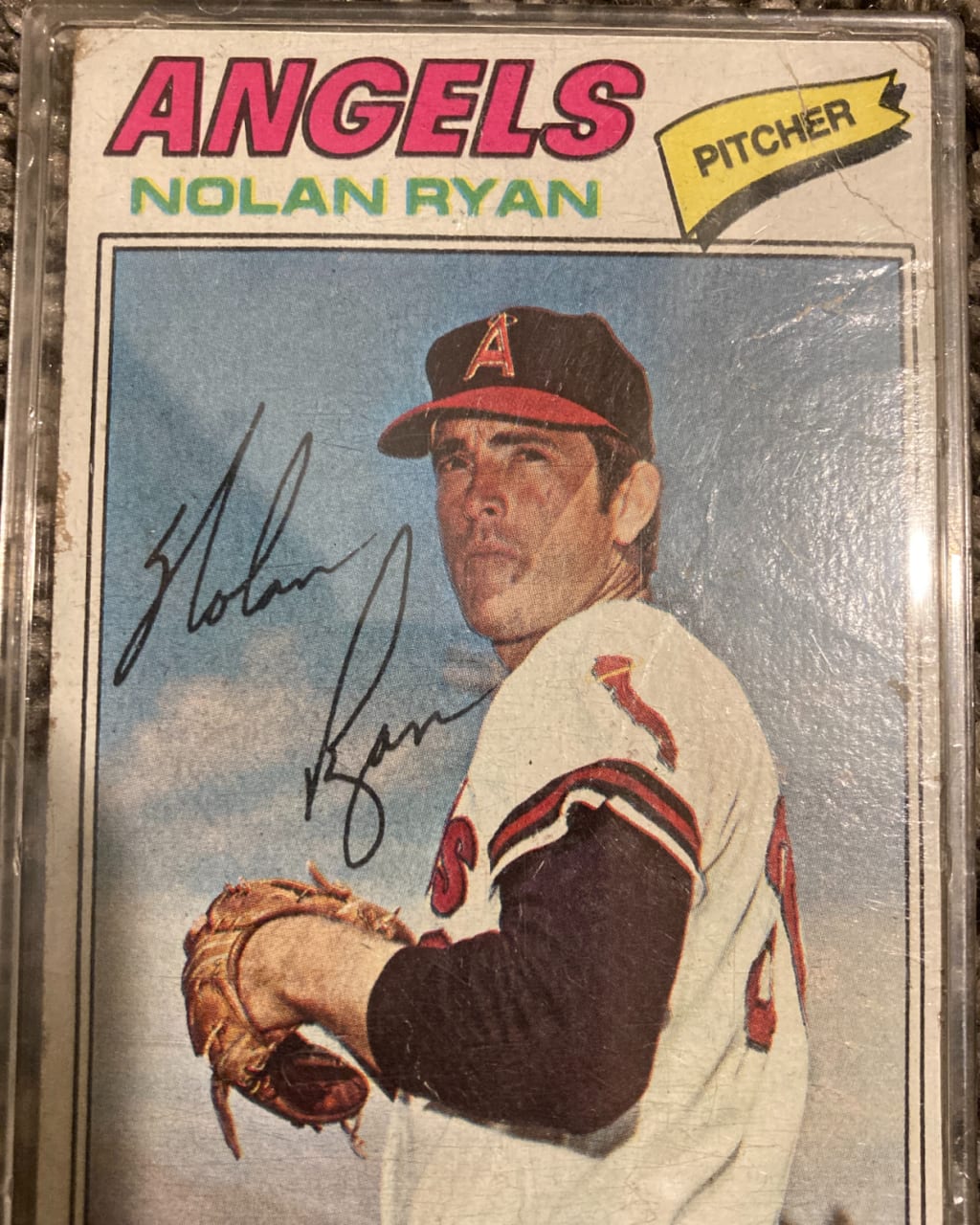
Nolan Ryan, 1977 Topps
If you have a Major League career in which you strike out 2,416 batters, that's ... pretty good. And yet that's fewer than half of the 5,714 strikeouts Ryan had in his Hall of Fame career, coming over the eight seasons he spent with the Angels from 1972-79. It's a career's worth, but don't tell that to the guys Ryan struck out while with California, who were sure to never forget just how difficult it was to get the bat on a baseball thrown by the all-time strikeout king.
The Halos made Ryan a full-time starter after acquiring him from the Mets, and the right-hander proceeded to lead the Majors in strikeouts in five of the next eight years (and the AL in seven of those eight seasons), solidifying himself as one of the best starters in the game. Four of Ryan's record seven no-hitters came while he wore an Angels uniform, including two in the same season in 1973. California was where Ryan rose to stardom, though his tremendous longevity would lead him to another 14 big league seasons after he left in 1980.
This 1977 Topps card captures Ryan as he gazes out toward the plate in his set position. His eyes are focused and he has the look of a man about to devastate his opponent. And the classic Angels uniform with the shape of California on the sleeves is a beautiful sight. Thanks to Justin of Huntington Beach, Calif., for submitting this one. -- Manny Randhawa

Aurelio Rodriguez, 1969 Topps
At first glance, there doesn’t seem to be anything remarkable about Rodriguez’s '69 Topps card, which was submitted by Michael Reay from Hot Springs, Ark., Dennis Berg from Rochester Hills, Mich., and Ryan Simpson from Greensburg, Penn. It depicts the third baseman in his Angels uniform, smiling and posing innocuously.
The thing is, that’s not Aurelio Rodriguez. It’s Leonard Garcia, who was the Angels batboy at the time.
Did Rodriguez pull a prank on Topps? According to a story from the Orange County Register, that wasn’t the case. Rather, a photo mix-up was the culprit.
Late in the '67 season, Rodriguez and Garcia were playing catch at Tiger Stadium when renowned baseball photographer George Brace approached them and snapped pics of both. But Brace mislabeled the two in his notepad.
“I could see that he got our names mixed up, but when I told him, all he did was draw a little half-circle reversal arrows by our names,” Garcia told the O.C. Register in 2019.
Due to a dispute with the newly formed Major League Baseball Players Association, Topps had to purchase photos from outside providers for their '69 set, and the one the company purchased for Rodriguez was actually the photo of Garcia that was snapped in '67. And thus, a classic error card was born. -- Thomas Harrigan
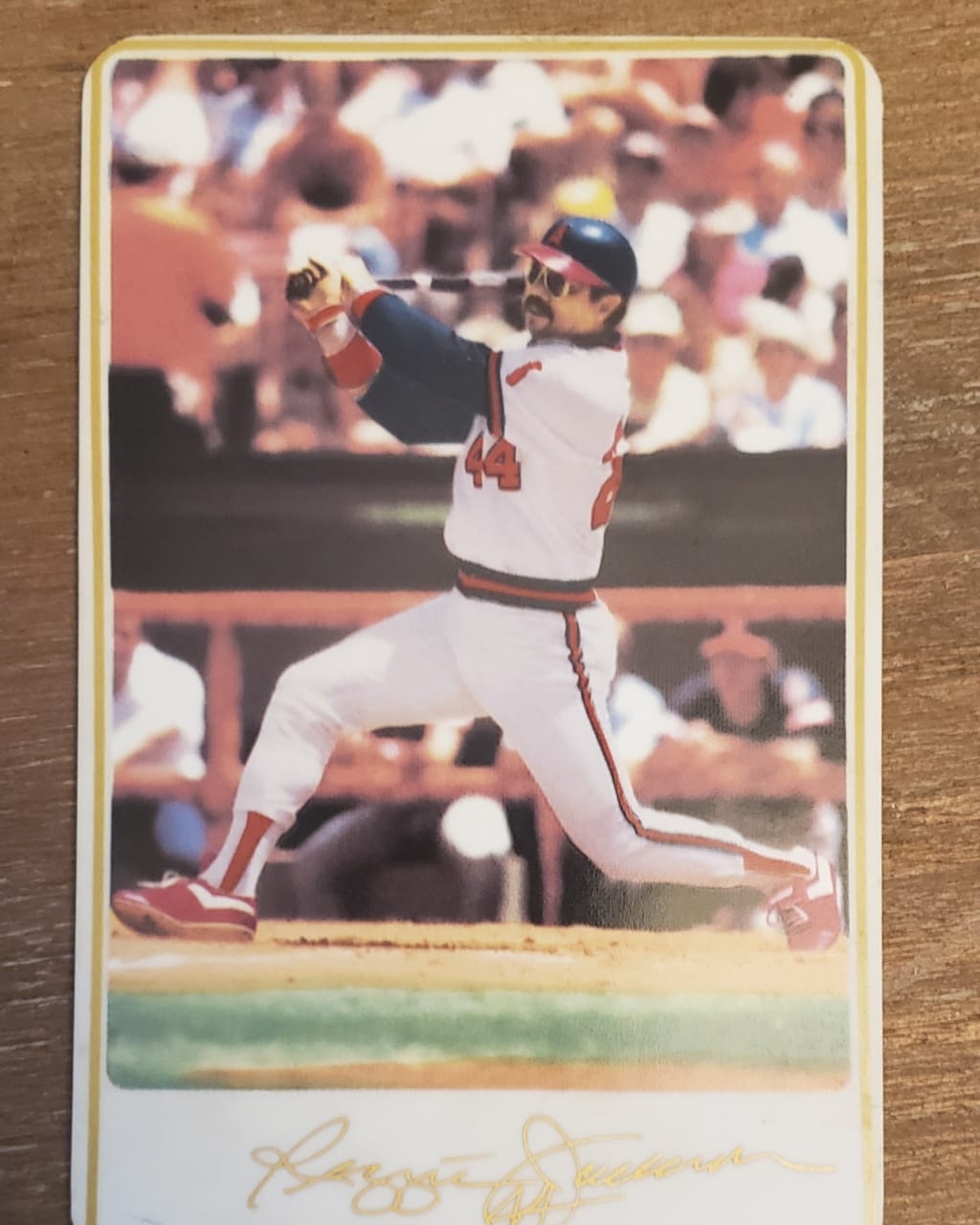
Best Angels facial hair card: Reggie Jackson, 1985 Armstrong's Pro Ceramic
When hearing the name Reggie Jackson, most people don't instantly see Mr. October in an Angels uniform. But he did play for California during his age-36 through age-40 seasons from 1982-86. Already a legend and destined for the Hall of Fame, Jackson's best campaign with the Angels was his first, when he posted a .907 OPS with an MLB-leading 39 homers. In all, Jackson hit 123 homers in his Angels career, but while he wasn't in the familiar Yankees pinstripes, one part of his look definitely didn't change: the facial hair.
The mustache Jackson had sported for so many years was then a goatee, as we can see on this 1985 Armstrong's Pro Ceramic card. He wasn't the same Jackson as he was in his prime, but for any baseball fan venturing out to watch an Angels game in 1985, the glasses, facial hair and physique were giveaways that the man at the plate was one of the most celebrated in baseball history. -- Manny Randhawa
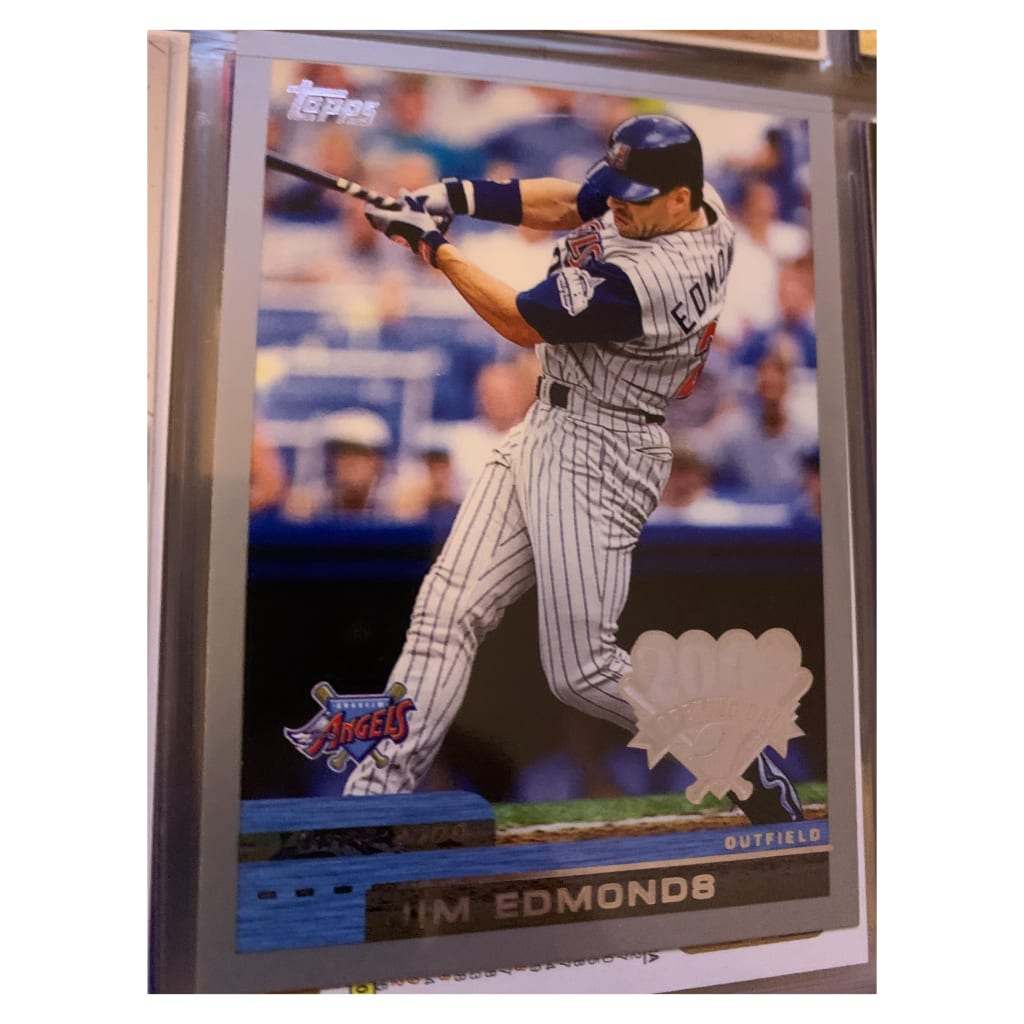
Jim Edmonds, 2000 Topps Opening Day
The highlight of this card is the Angels' classic uniforms, from the pinstripes to the blues and reds that defined the team when it was known as the Anaheim Angels. ("Love these Angels uniforms," says Brett Shaver of Cleveland, who submitted the card.)
You see that logo on the bottom left of the card, too, with the angel wings wrapped around the "A" in Angels. The Halos used that logo from 1997-2001.
Edmonds is captured just after connecting on his swing, eyes still locked on where the ball was the moment it met his bat. The year 2000 also happened to be the year Edmonds went from the Angels to the Cardinals, but he had some great years in Anaheim.
Edmonds was an All-Star for the Angels in 1995, won American League Gold Glove Awards in center field in '97 and '98 and had four straight 25-homer seasons from '95-98.
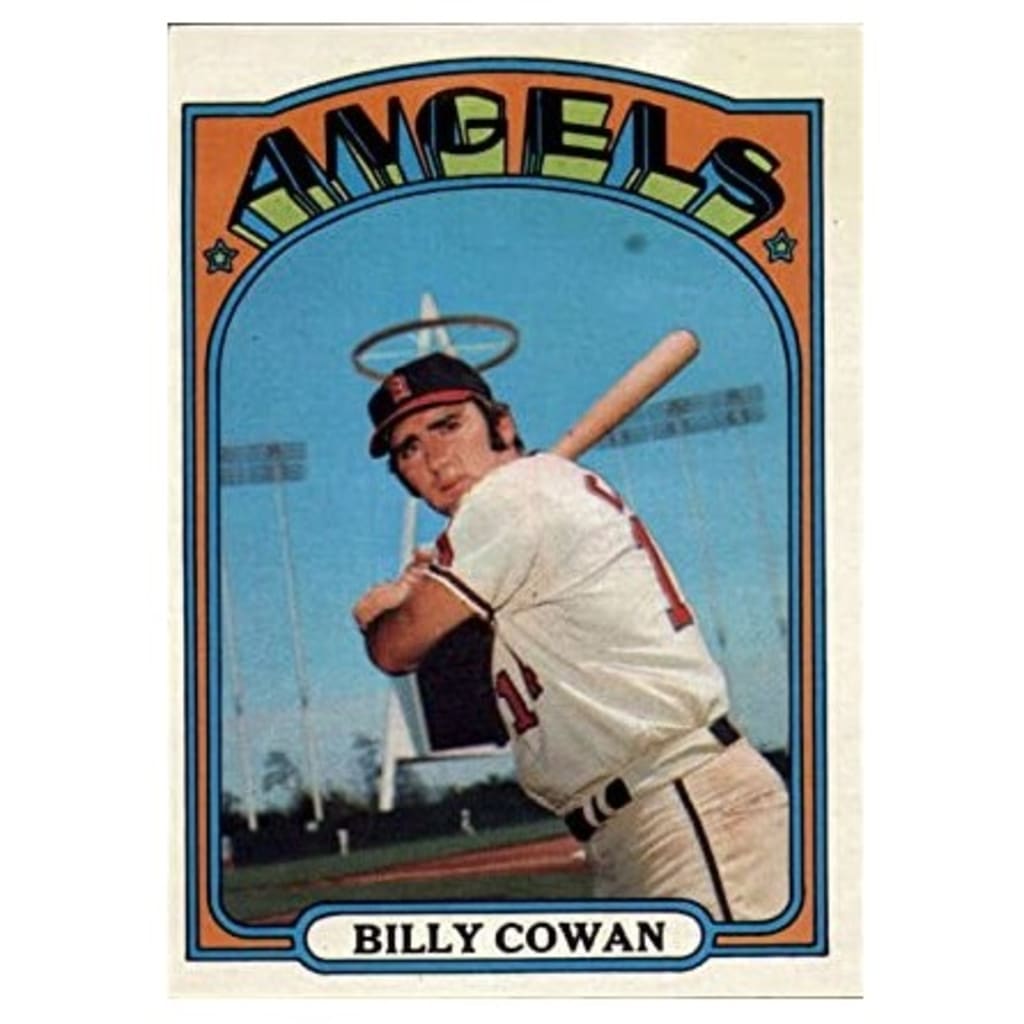
Billy Cowan, 1972 Topps
While Cowan played only 173 games and hit 13 homers over four years with the Angels, the outfielder’s 1972 Topps card left a lasting impression on Doug Wulf of Cedar Rapids, Iowa.
“A favorite card of mine -- way back to when I got it out of a pack as a kid -- was the 1972 Billy Cowan," Wulf said. "I always appreciated the cleverness of the photographer to set up that shot, where the halo from the ‘Big A’ -- then beyond center field at the Angels' stadium -- appeared to be a halo over Cowan’s head.”
As Wulf notes, the famous "Big A" sign initially was situated beyond the outfield fence at then-Anaheim Stadium, allowing for this fun and memorable shot of Cowan.
The sign was moved to the parking lot in 1979, as the stadium was retrofitted to make it suitable for football games before the Los Angeles Rams starting playing there. It still stands there to this day. -- Thomas Harrigan
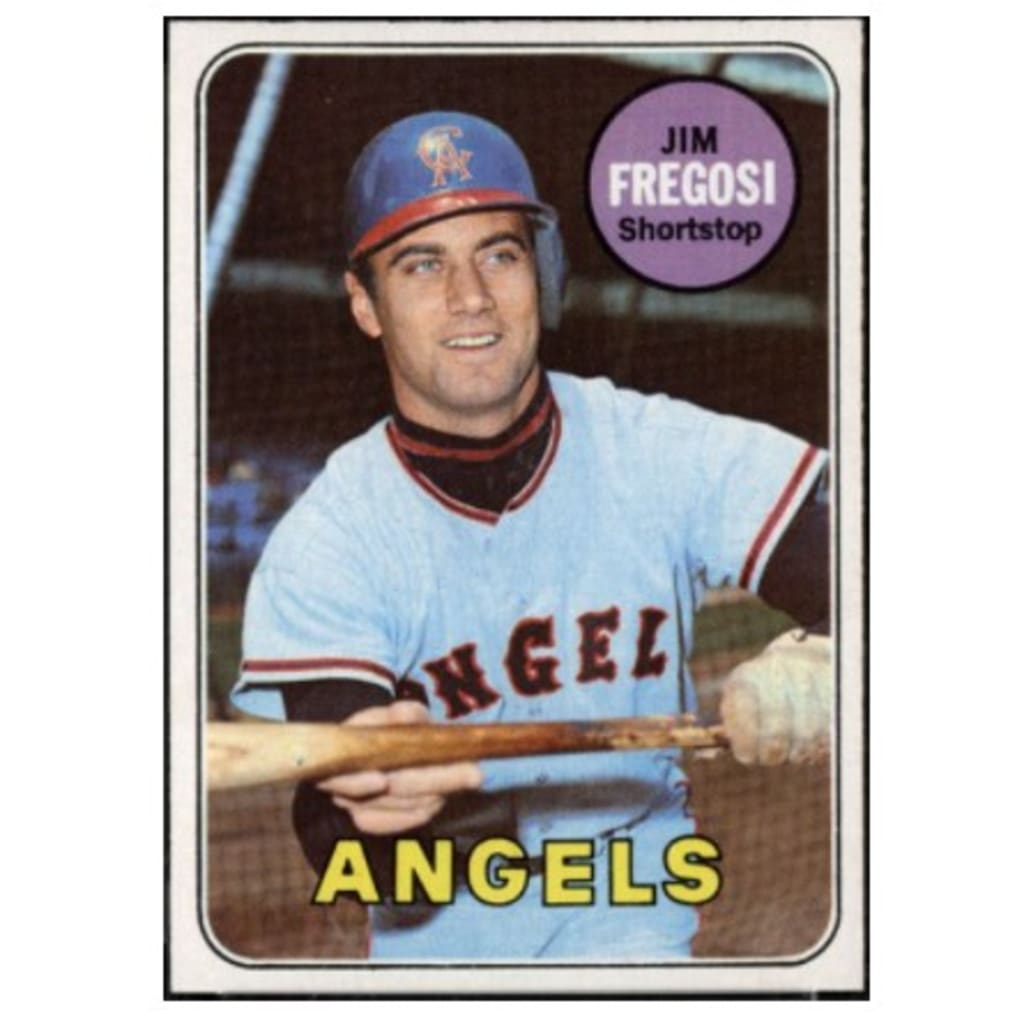
Jim Fregosi, 1969 Topps
Part of the magic of baseball card collecting is that certain cards have the power to take you back to a specific place and time.
For Stan Masumoto of Redondo Beach, Calif., that card is the 1969 Topps Jim Fregosi.
“Looking at it transports me back to my Little League days in Carson, Calif., where I was introduced to baseball and baseball cards in the spring of 1969. Nestled in the rear of the main diamond backstop was a concession stand selling candy and packs of Topps baseball cards. Each pack cost a nickel and included a stick of chalky pink bubble gum.
"My first pack contained a Jim Fregosi card. … The card depicts Jim in the batting cage as he prepares to take his first few pitches for bunting practice. The two-toned batting helmet displays the bright red California Angels logo of the time. His hands hold the pine-tar-stained bat in perfect position. The back of the card provides everything you need to know about Jim through his 1968 season. The illustration of him holding home plate as he scores one of his two inside-the-park home runs at Chavez Ravine is classic. It reminds me that Jim was a member of the Los Angeles Angels, whose home field was Dodger Stadium before the team’s name change and move to Anaheim. I couldn’t believe the news on December 10th, 1971, when Jim was traded to the Mets for some guy named Nolan Ryan.”
As Stan noted, Fregosi was traded to the Mets for Ryan and three others after the 1971 season, ending his 11-year tenure with the Angels that included six All-Star selections. The infielder played seven more seasons after the trade but never made another All-Star team. -- Thomas Harrigan

Ken Hunt, 1962 Topps
This is a special, special card. We'll let the man who submitted it in our survey, Steve B., explain as only he could.
"I nervously approached the tall, distinguished-looking man who was chatting with a group of fellow golfers. In my hand was a 1962 Topps baseball card bearing the likeness of the former outfielder for the Yankees, Angels and Senators. I swallowed hard and stammered out a request for an autograph.
"On that day in June 1989, Ken Hunt’s face absolutely beamed. With a flourish, he signed the card, 'Good Luck Steve, Ken Hunt.' I had no idea my life had just changed. And changed so much for the better. Ken was one of the many former ballplayers who had come to Fargo, N.D., for the annual Roger Maris Celebrity Benefit Golf Tournament. At the time, I was a first-year committee member, assigned to help with the promotion of the tournament. Ken and I hit it off from the very beginning, and that simple act of signing an autograph triggered one of the strongest friendships of my lifetime.
"Through the ensuing years, Ken and I had many wonderful times together, and he was an amazing host during my visits to his home turf of Los Angeles. Ken was a fine player, as demonstrated by his 25 home runs and 84 RBIs for the 1961 expansion Los Angeles Angels. But I came to understand and respect him greatly as a truly kind and generous man.
"Ken passed away on June 8, 1997, just a few days after we had talked on the phone about having dinner together at that year’s upcoming Maris Tournament. That 1962 Topps card brought Ken and me together. ... Our youngest daughter, McKenzie, is named in Ken’s memory. She is at home at any ballpark she can find, and now at age 16, Kenzie (much like her namesake) can absolutely clobber a pitch over the inside part of the plate.
"My eyes well up when I think about Ken. His genuine love for life was infectious, he could hit a golf ball a country mile and his heartfelt sincerity touched everyone around him. I loved the way he gave humongous hugs to his pals, and he gave many, many hugs. I have a tattered 1962 Topps card to thank for all this. Thank you, Topps."
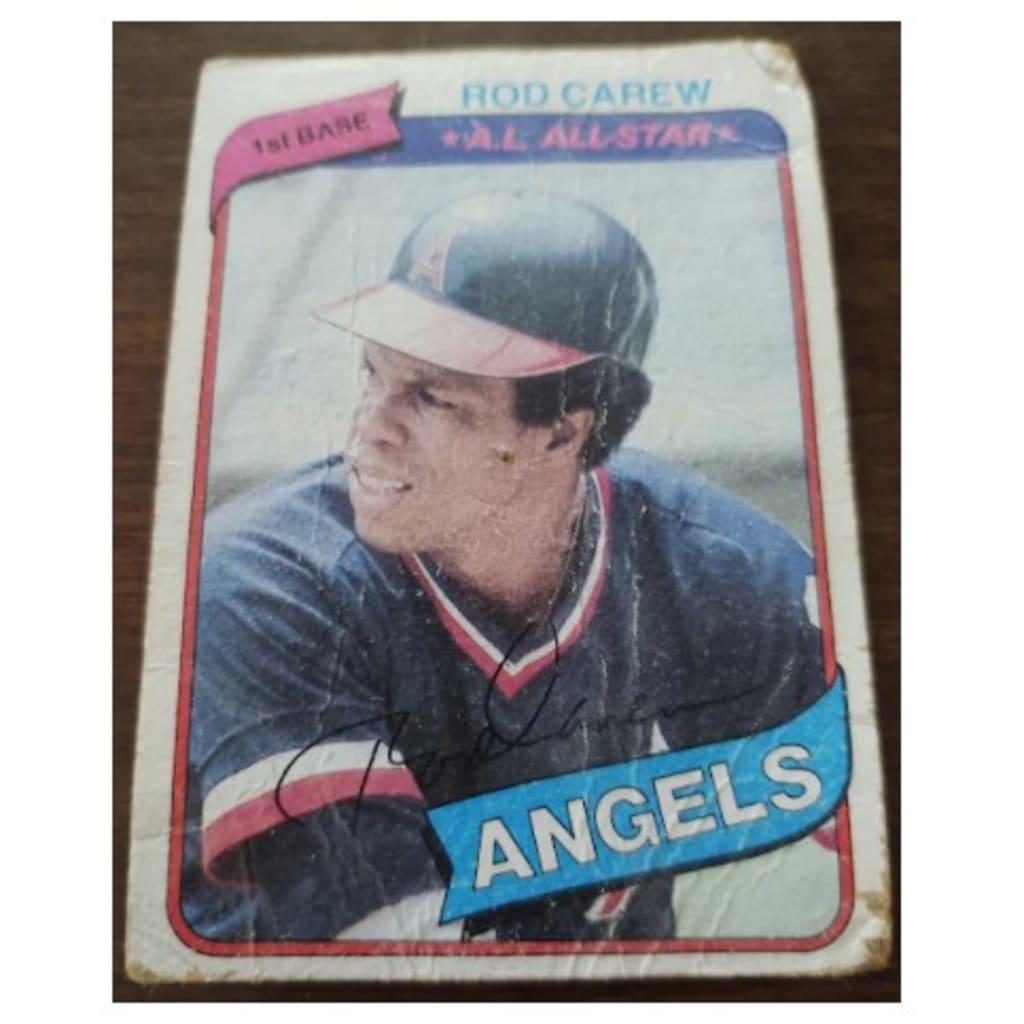
Rod Carew, 1980 Topps
Ralph Grambusch’s Carew card from the 1980 Topps set has been worn down over the years, but the journey is part of its charm.
“My first card … 10 years old and a buddy of mine bought some cards at the corner gas station,” wrote Grambusch, who hails from Waxahachie, Texas. “Asked me if I wanted one of them and I chose my dad's favorite player. As you could tell from the picture, we did not care about condition. That card stayed in my pocket while we went swimming, played football, etc.; everything you did as a 10-year-old. Nice pin hole in the center showing it stayed on my bedroom wall for years growing up in the 80s. It is memorable to me because it kicked off the hobby I have been enjoying for 40 years now with 300,000 cards now and counting but this one is my showcase card. My wife does not understand. Thanks dad, baseball and Rod Carew.”
And thanks to Ralph for sharing a story we can all relate to. -- Thomas Harrigan
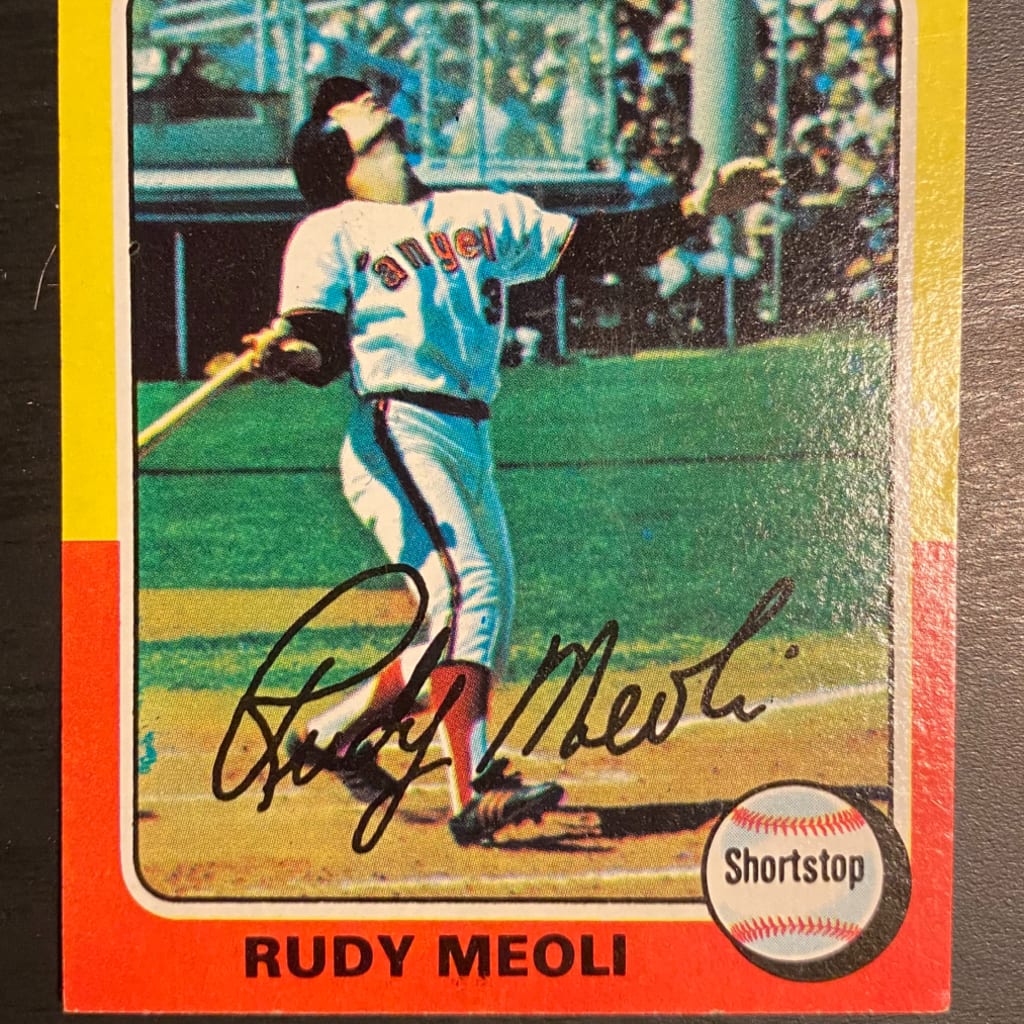
Rudy Meoli, 1975 Topps
There are some cards that truly capture a great action shot of a player doing what he does best, whether that be throwing 100 mph fastballs from the mound or hitting tape-measure homers. And then there are some cards that ... don't.
Meoli's 1975 Topps card is definitely in the latter category, and that's why it's a favorite of the person who submitted it in our survey, Chip T.
"Popping a ball straight up in the air is one thing. Having someone capture it and stick it on your baseball card is quite another," Chip wrote. "Popping a ball straight up in the air will forever be a ‘Meoli.'"
Unfortunately for Meoli, not only did he have a less-than-flattering 1975 Topps baseball card, but his numbers at the plate didn't really help his cause, either -- he was a career .212/.289/.267 hitter. -- Manny Randhawa

1990s throwback card: Chuck Finley, 1994 Upper Deck
Here’s Finley jamming out during warmups and showing off his air-guitar skills on a bat. Sprawled out on the field with his hat on backwards, the lefty is lost in the moment and doesn’t seem to care who’s watching.
Finley’s performance made for an unforgettable card that was part of Upper Deck’s 1994 set.
“I have always thought that Chuck Finley’s 1994 Upper Deck was unique just because he is blending his two loves of baseball and rock and roll by playing air guitar on a bat,” wrote Noah Gill, who submitted this card in our survey. “His facial expression on the card makes me laugh every time.” -- Thomas Harrigan
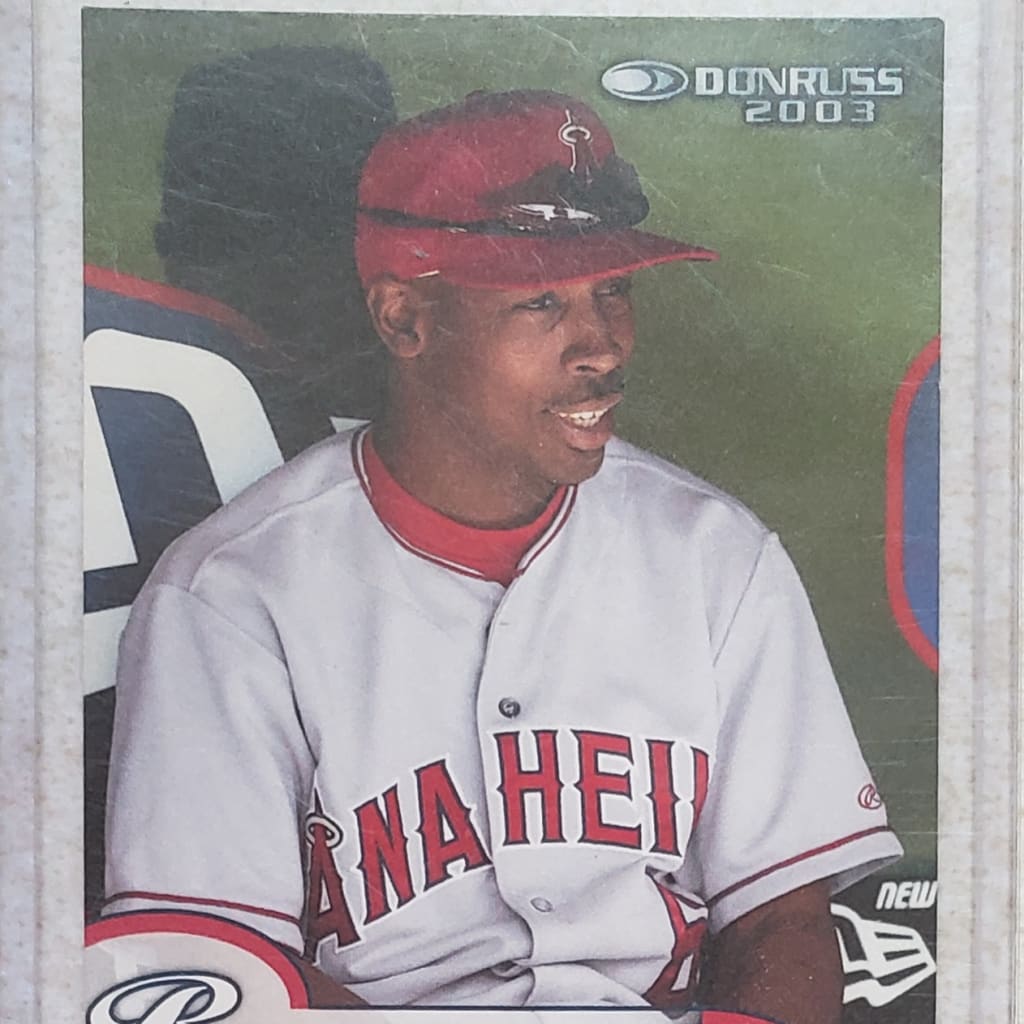
Chone Figgins, 2003 Donruss
There's an incredible story behind this card in the case of Joseph from Salem, Virg., who submitted it in our survey. Only he could tell it best, and fair warning: it's a tear-jerker:
"I grew up going to Salem Avalanche games with my grandpa in the late '90s and early 2000s. Our mutual favorite was Carolina League All-Star SS Chone Figgins (he moved to second in 2000 to make way for Juan Uribe). At this point, my baseball knowledge was exclusively Salem Avalanche -- I knew nothing about Major League Baseball.
"Fast-forward to April 2003, and I'm at a game with my grandpa. He had given me a few bucks to get a pack of cards from the store. I settled on a 2003 Donruss set because it had Sammy Sosa on the packaging (and despite it containing less cards than the Topps set). I rip it open and the very last card is none other than a Chone Figgins rated rookie. I sprint back through the concourse and up to our seats to show Poppy my new prized possession. It was at that exact moment that I not only learned about the Anaheim Angels, but I became a diehard Angels fan for life.
"Fast-forward about 10 years and Poppy is losing a battle with dementia and is in a memory care facility. Outside of his room is a shadowbox filled with personal items that will hopefully ignite his memory and help him to converse with others. In the case is that exact Chone Figgins card I pulled 10 years earlier. The two of us were walking around the room together when he stops at his shadowbox. That's when my grandfather, who would often forget my name, looked at me and said 'Chone Figgins. Now he was a great ballplayer. Do you remember him?'
"I just gave him a smile and said, 'Yeah, Pop. I remember.'"
What a story. Baseball cards have far more meaning behind them than the picture of the player on the front, or his stats on the back. -- Manny Randhawa
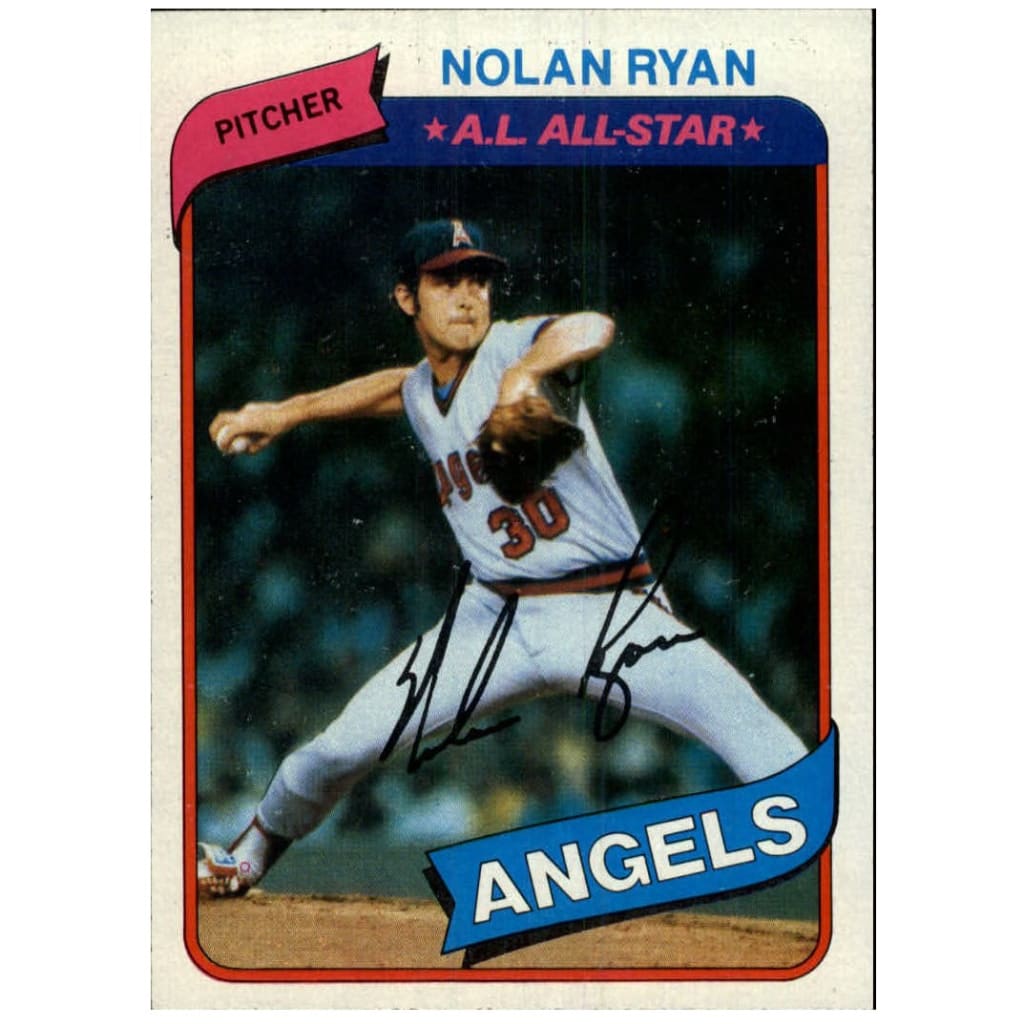
Nolan Ryan, 1980 Topps
Philadelphia’s Brian Tweed and Ontario, Canada’s Paul Speight have at least two things in common: they both submitted Ryan’s ‘80 Topps card in our survey, and they both named a son after the Hall of Fame flamethrower.
Although Ryan joined the Astros as a free agent shortly after the ‘79 season ended, his ‘80 Topps card still shows him as a member of the Angels. His ‘80 O-Pee-Chee (Canada’s version of Topps) card features the same image but lists him with the Astros.
“My most memorable baseball card is the Topps 1980 Nolan Ryan,” Tweed wrote. “At that time I'd only been a fan of MLB baseball and baseball card collecting for one year. I vividly remember opening the pack of cards, seeing the Nolan Ryan card, and feeling like I'd found a gold coin. That rush helped turn an interest in baseball cards into a passion. It helped nurture my love of baseball that has lasted my entire life. That particular card turned me into a big Nolan Ryan fan. It is, perhaps, not a coincidence that when it came time to choose names for my son, Nolan was at the top of the list. Even now, 41 years after opening that pack of cards, when I see or think about my son, that card often comes to mind.”
“I grew up in Canada so we had the O-Pee-Chee version with Ryan already [on the] Astros, wrote Speight. "Once I moved to a bigger city with access to the Topps cards I sought out the Ryan, it was and still remains my favorite baseball card ever. Iconic. I named my son Ryan after Nolan, even.” -- Thomas Harrigan
